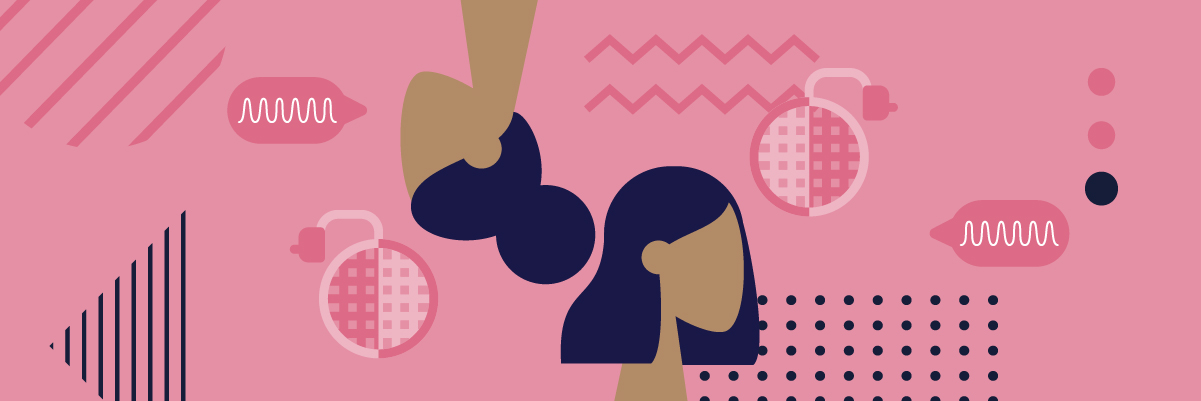A pop filter is essential for any singer or voice-over actor. But what are these devices, and what makes them so important?
If you’ve ever heard an announcement made through a microphone, you know how much the sound is ruined by the popping and banging noises that you don’t hear normally. If these noises sound horrible during live events, it’s even more disastrous when heard on recordings. Bad audio can ruin movies, content for marketing, and other types of media. These are some of the reasons that make a pop filter so valuable to any project involving voice and audio.
What Is a Pop Filter?
Even the best voice-over artists or singers still get mic pops on some occasions. At both home and professional studios, you may see a screen made with a nylon or mesh material that is clipped to the mic stand. This usually sits a couple of inches in from of the microphone. A pop filter or pop shield transforms the recording by getting rid of plosive sounds.
Usually, the sound passes through the microphone with a high-frequency, but if there’s a pop filter, it will be stopped dead since the mesh breaks down the pop of air from the mouth. When this noise becomes turbulent, it will lose its coherence. Therefore, what started as a mass of air will end up being randomized, so its air molecules will no longer push in the same direction. It’s a very simple and straightforward concept, but it works wonders.
To make a pop shield more effective, some products have two mesh layers placed a couple of millimeters apart. This is helpful because whatever sound is not blocked by the first layer, it will be stopped by the second. However, it’s also important to remember that the pop filter should be placed only a couple of inches in front of the mic since the air needs to pass through between the pop shield and the microphone.

How Do Vocal Pops Happen?
The annoying thumps and pops you hear when someone uses a microphone are known as plosive sounds. It is more evident when you use the letter “P” or “B.” The best way to know whether a word has a plosive sound or not is if you say the word while holding a candle in front of you, the candle will flicker a bit. However, if you say words that don’t have a plosive sound, the flame from the candle will barely move. This means you are producing little air in the process.
The problem with plosive sounds is they will sound worse when the microphone is close to your mouth. When the air blasts into your microphone, it produces an output signal that can saturate or overload the microphone’s preamp, making the sound more annoying. While you may simply ease the overloading system by engaging your mic’s low-cut filter, this won’t be enough to entirely get rid of the popping sound.
The problem can even intensify because directional microphones have a bad reaction to the proximity effect, where a bass tip-up makes the mic more sensitive to low-frequency sounds from a close source. This is what your plosive sound is exactly like – a low-frequency sound that is translated into a loud thumping sound.
The microphones used in studios are very susceptible to popping because the diaphragm is light. Having a pop filter or screen is necessary. If you have a dynamic microphone, it is more tolerant because of its bigger diaphragm assembly. However, this doesn’t mean its sound is free of plosive sounds.
Other Uses of a Pop Filter
There are other uses of a pop filter aside from making sure the plosive sounds are not heard in your recording. Another major benefit of this device is it protects your microphone and prolongs its life span. When a person sings or talks in front of a microphone, there will be a combination of saliva, dust, and moisture that will be forced inside the microphone’s capsule.
The internal components of microphones are very delicate, so if you invested a good sum of money for your microphone, the last thing you want is to damage it. While saliva, dust, and moisture won’t do damage if it happens only a few times, it can cause mold to grow in the long run. This can make your microphone unhygienic and unpleasant.
Thankfully, a pop filter is very easy to clean. Simply soak it in hot water with a non-abrasive cleaning product, and you’re all done. This will also give you peace of mind if your microphone is used by many singers.
What to Look for in A Pop Filter
In time, your pop filter may sag and therefore refuse to stay in place. This is very frustrating since it wastes important time in the setup process. Therefore, it is recommended to splurge a bit on a pop filter that has a flexible arm.
Look for a pop filter with a strong squeezable clamp instead of a screw-based one since the latter takes more time to set up. Replaceable filters are also a great idea. This way, you won’t have to replace the entire thing if it gets damaged, especially if you’re on the road.
Types of Pop Shield
You may ask yourself, do you need a pop shield? The answer is a resounding yes. These devices are your best option if you want to maintain the quality of your recording. While you may position yourself off-axis to the microphone and not breathe directly on it or fix the plosive sound during the post process, it’s still more convenient to install a pop filter. But what’s the best pop filter for you, and what are the advantages and disadvantages that each type provides?
Nylon pop filter
Nylon pop filters use a double layer of nylon fabric that is stretched inside a plastic or metal ring. The fabric will dramatically defuse the air coming from your breath, so by the time it reaches the microphone, all unwanted air will be gone. These types of pop filters are inexpensive and mostly used in home studios. However, it can easily get damaged because the material is delicate.
Metal pop filter
This type of pop filter has just one layer of thin metal. It has a distinct pattern, and its shape is triangular at the bottom and rounded at the stop. This way, when a voice actor’s breath is in contact with it, the air is deflected in an almost straight down direction.
This pop filter is more transparent compared to the nylon pop filter, but its durability is better because of its material. This filter also has a smaller size compared to the nylon one. However, it can easily get bent because of its thinness, and it may produce a whistling sound if air goes through it.
How About a Foam Windscreen?
When you purchase a professional microphone, it may come with a foam windscreen. These devices are made with a one-half-inch thick foam, and it is meant to be inserted over the top of your microphone. This diffuses the air before it gets to the microphone itself.
So the question is, can you use this as an alternative to a pop filter? The answer is no. This device is meant to deflect the wind when the microphone is used outdoors. This is very handy on film shoots, interviews, and concerts. This means that it would not do anything to get rid of the concentrated wind that comes when you say a plosive sound.
Because singers or actors are closer to the microphone, it won’t make much of a difference. Foam windscreens help to cut the top end of microphone sounds therefore making you sound worse.
Unless you want to use it outdoors, stay away from a foam windscreen.

How Far Should the Pop Shield Be from Your Microphone?
How far you position your pop filter from your microphone will make a difference in the sound. As a rule, the distance will be determined by the energy of the recording artist. The farther the pop filter from the microphone, the more the pops will be eliminated. However, the farther the pop filter is to the microphone, the more the person recording needs to increase the microphone gain or their voice.
For instance, if a voice over artist is recording a script for a lively adventure video game, the pop filter should be around 4 or 5 inches distance from your microphone. If a voice-over artist is recording an employee training audio, the pop filter can be two or three inches away from the filter.
That being said, the key to having the best sound is to experiment and find the best distances that suit your specific microphone and pop filter, as well as the room ambiance. It is also important to familiarize yourself with the genre and style of the recording.
Making A DIY Pop Filter
Pop filters are inexpensive, but you can make one yourself since it’s quite easy. All you need is a sewing circle and a cheap pantyhose. Simply put the pantyhose over your sewing circle, and you’re done. The challenge with this simple DIY is how to attach the filter to your microphone stand. This is easy to do with a hanger or a clamp.
Having a Pop Filter Can Make or Break Your Recording
A great pop filter is one of the must-haves in your studio kit. Thanks to this helpful device, you will have better sound quality. And as an added bonus, it will also increase the lifespan of your microphone. Instead of having your microphone constantly repaired or replaced, you can just clean your pop filter. If you need a grade-A voice-over, Bunny Studio can help you.










